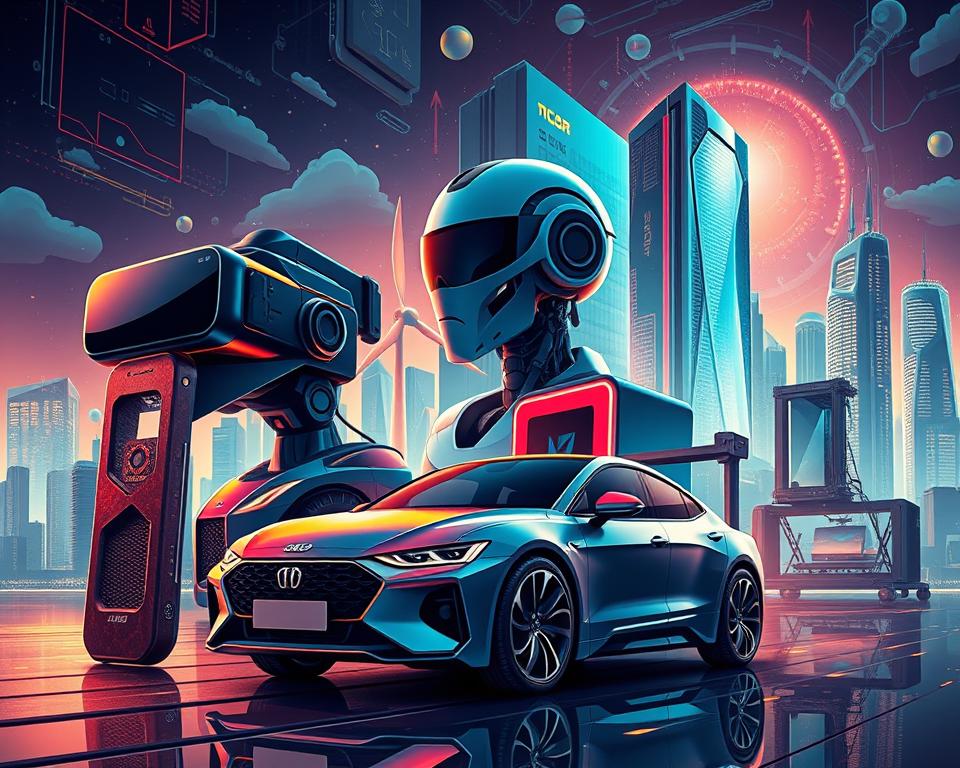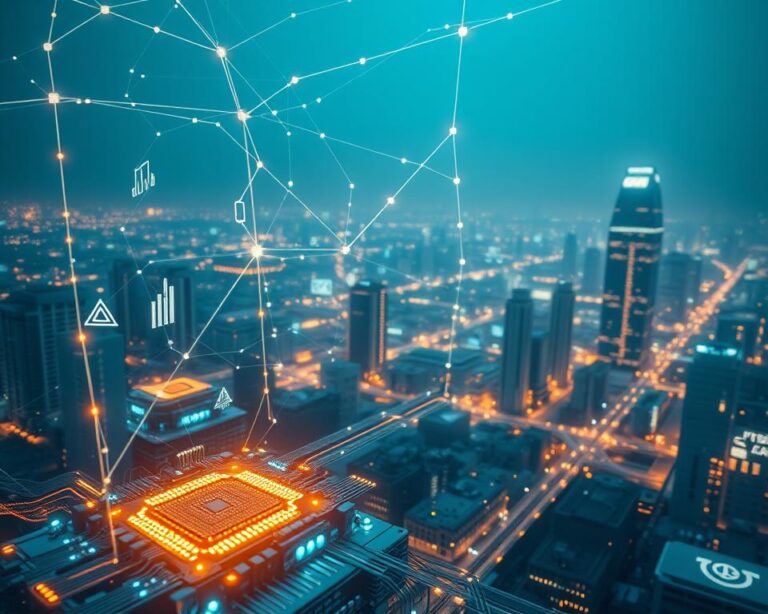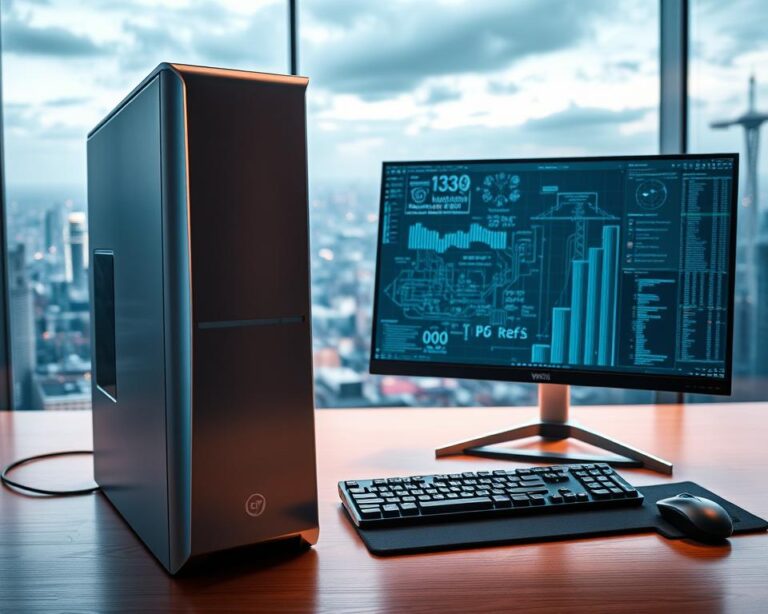
7 Transformative Technologies You Should Know
Did you know that over 92% of organizations across the globe are integrating some form of transformative technologies into their operations? This staggering statistic showcases the rapid pace at which innovation is reshaping our world. In today’s fast-evolving landscape, understanding the impact of these technologies is essential for staying ahead. In this article, we will explore a modern technologies list that highlights the 7 types of technology with examples that are transforming industries and enhancing our everyday lives.

Key Takeaways
- Transformative technologies are innovating various industries.
- Understanding AI is crucial as it becomes increasingly integrated into daily life.
- Blockchain technology is reshaping how we handle transactions securely.
- 5G technology is revolutionizing communication and connectivity.
- Renewable energy advancements are paving the way for a sustainable future.
Introduction to Transformative Technologies
Transformative technologies refer to significant advancements that dramatically alter the ways we live and work. These innovations shape our daily experiences, influencing everything from communication and transportation to healthcare and education. Understanding the concept of transformative technologies is essential as the world increasingly relies on modern technology advancements to address pressing societal challenges.
Throughout history, several transformative technologies have emerged, each playing a crucial role in facilitating progress. The internet and smartphones are notable examples, as they revolutionized how we connect, access information, and conduct business. Such advancements emphasize the importance of remaining informed about how technology influences our lives. Adapting to these changes can lead to improved efficiency, productivity, and quality of life.

The Rise of Artificial Intelligence
Artificial intelligence, often referred to as AI, has undergone significant advancements in recent years. This transformative technology enables machines to perform tasks that typically require human intelligence. Functions such as data processing, problem-solving, and language understanding exemplify the depth of AI applications. As organizations adopt AI, its impact reaches a wide array of sectors, revolutionizing efficiency and effectiveness.
What is Artificial Intelligence?
At its core, artificial intelligence encompasses a variety of algorithms and data sets that empower machines to mimic cognitive functions. These systems are designed to learn from experience, adapting to new inputs and enhancing their performance over time. Machine learning and neural networks are key components allowing AI to process vast amounts of information and make informed decisions. The ability to analyze data patterns opens doors to innovative applications in numerous fields.
Examples of AI in Everyday Life
AI applications are woven into the fabric of daily experiences. Virtual assistants such as Siri and Alexa simplify task management through voice interaction. Recommendation systems on platforms like Netflix and Amazon utilize AI to personalize user experiences based on preferences. Automated customer service chatbots provide quick responses to inquiries, showcasing the AI impact across various industries. These examples highlight the growing importance of artificial intelligence in enhancing convenience and accessibility.

The Power of Blockchain Technology
Blockchain technology represents a revolutionary approach to data management through its secure and transparent framework. As a form of decentralized systems, it allows users to participate directly without needing intermediaries, fostering trust and transparency. This innovative technology has a significant blockchain impact across many domains, from finance to healthcare.
Understanding Blockchain
The foundational concept of blockchain technology involves a series of blocks that securely store data. Each block contains a record of transactions or data entries interconnected in a chain. Consensus protocols validate these transactions, ensuring that all parties agree on the information shared. The use of cryptographic techniques guarantees security, making it difficult for unauthorized individuals to alter any recorded data.
Real-World Applications of Blockchain
Blockchain technology has found practical applications in several areas. Notably, cryptocurrencies such as Bitcoin and Ethereum utilize blockchain for secure transaction recording. Smart contracts automate agreements between parties, increasing efficiency and reducing the risk of fraud.
In real estate, blockchain allows for transparent property transactions, minimizing the chances of fraud and ensuring clear ownership records. The healthcare industry benefits from this technology through improved patient data management and verification, providing greater security for sensitive information. Identity verification solutions also employ blockchain to streamline processes while enhancing security.

Revolutionizing Communication with 5G Technology
5G technology represents a significant leap forward in mobile connectivity, changing the way we communicate with unprecedented speed and efficiency. The enhancements offered by this next-generation network enable data transfer at remarkably high rates and minimize latency. These improvements are crucial for applications that demand real-time responsiveness such as telemedicine and online gaming.
The capacity to connect more devices simultaneously creates a fertile ground for communication advancements, fostering innovations in smart cities and IoT solutions. As cities integrate 5G networks, the potential for improved traffic management, remote monitoring, and simulation increases, demonstrating the transformative effect of this technology on urban living.
With 5G technology, users can experience high-definition video streaming without buffering, seamless video calls, and instant data downloads. As this technology continues to evolve, its impact on various sectors will be profound, reshaping the landscape of mobile connectivity.

7 Types of Technology with Examples
Exploring different types of technology reveals how they shape our world today. In our examination, we will categorize technologies into various groups, such as communication, energy, healthcare, and automation, highlighting some 7 types of technology examples within each category. Understanding these technology categories not only provides insights into their individual characteristics but also showcases their versatile applications across multiple industries.
Overview of Various Technology Types
Each of the technology categories offers unique functionalities that enhance our daily lives and professional endeavors. Here are some notable examples:
- Artificial Intelligence (AI) – Used in industries like healthcare for diagnostic purposes.
- Blockchain – Known for its security and transparency in financial transactions.
- Renewable Energy Technologies – Harnessing solar and wind energy to address environmental challenges.
- Internet of Things (IoT) – Enabling smart home devices that improve convenience.
- 5G Technology – Enhancing mobile connectivity and data download speeds.
- Virtual and Augmented Reality – Transforming entertainment and education with immersive experiences.
- Automation – Streamlining manufacturing processes to increase efficiency.
Diverse Applications Across Industries
Technologies manifest in practical applications tailored to meet the demands of various sectors. Below is an overview of how different types of technology influence industries:
| Industry | Technology Type | Application |
|---|---|---|
| Pharmaceuticals | Artificial Intelligence | Drug discovery and development |
| Agriculture | Internet of Things | Smart farming techniques for improved yield |
| Finance | Blockchain | Secure transactions and smart contracts |
| Manufacturing | Automation | Robotics for assembly lines |
| Entertainment | Virtual Reality | Immersive gaming experiences |
The Impact of Virtual and Augmented Reality
Virtual reality (VR) and augmented reality (AR) are transforming various sectors, notably gaming, training, and retail. These technologies immerse users in interactive experiences that enhance engagement. The VR impact reaches beyond entertainment, influencing how people learn, connect, and shop.
What is Virtual Reality?
Virtual reality creates an immersive environment where users can interact with 3D spaces using headsets. Such experiences replicate the real world or transport users to entirely new realms. Education, therapy, and entertainment benefit from virtual reality applications, allowing for hands-on learning and impactful experiences.
Applications of Augmented Reality in Business
Augmented reality applications have gained traction in numerous business sectors, enhancing user engagement and operational efficiency. For instance, IKEA’s app allows customers to visualize furniture in their homes before making purchases. This practical application exemplifies how AR can drive consumer satisfaction. Additional uses span from training simulations to real-time information overlays in various industries.
| Technology | Field | Application | Benefits |
|---|---|---|---|
| Virtual Reality | Education | Immersive learning environments | Enhanced understanding and retention |
| Virtual Reality | Therapy | Exposure therapy for phobias | Safe, controlled environment |
| Augmented Reality | Retail | Visualizing products in real settings | Increased customer engagement |
| Augmented Reality | Training | Simulated on-the-job scenarios | Improved skill development |
Advancements in Renewable Energy Technologies
The quest for a sustainable future drives rapid advancements in renewable energy technology. These innovations focus on harnessing natural resources, reducing dependence on fossil fuels, and mitigating climate change. Prominent contributors include solar and wind energy, both of which showcase significant growth and improvement.
Key Types of Renewable Energy
Several types of renewable energy sources are crucial for powering the planet sustainably:
- Solar Energy: Derived from sunlight, solar power innovation continues to progress, making solar panels more efficient and accessible.
- Wind Energy: With wind energy advancements, new turbine designs maximize energy capture while minimizing environmental footprints.
- Hydropower: Utilizing flowing water, this method remains one of the oldest renewable energy forms.
- Geothermal Energy: Tapping into the earth’s heat offers a reliable energy source less impacted by weather fluctuations.
- Biomass: This involves converting organic materials into energy, contributing to waste reduction and energy production.
Innovations in Solar and Wind Power
Recent developments in solar power innovation focus on enhancing efficiency and reducing costs. Important breakthroughs include tandem solar cells, which stack multiple layers to capture more sunlight and convert it into energy.
Wind energy advancements have led to the design of larger, more efficient offshore wind farms. These offshore installations benefit from stronger and more consistent winds, providing a significant energy yield while protecting marine ecosystems.
As the world continues transitioning to renewable energy technology, these innovations play a vital role in achieving a cleaner, more sustainable energy landscape.
Exploring the Internet of Things (IoT)
The Internet of Things (IoT) has emerged as a fundamental force transforming how we interact with technology. This network of interconnected smart devices allows for seamless communication and data exchange, fostering innovation across various sectors, including healthcare, agriculture, and transportation.
IoT applications are expanding rapidly, leading to enhanced efficiency and productivity. For example, smart thermostats can optimize energy usage in homes, while wearable devices may track health metrics and provide real-time feedback. The ability for these smart devices to communicate and work together is pivotal in realizing the full potential of the Internet of Things.
Interoperability plays an essential role in the effectiveness of IoT applications. Devices from different manufacturers need to be compatible to ensure seamless communication within the IoT ecosystem. As a result, standardization efforts are underway to facilitate smoother interactions between smart devices. This is crucial for creating a cohesive environment where data flows freely, allowing users to gain valuable insights.
In summary, the Internet of Things is shaping a future where technology enhances our daily lives through smart device integration and meaningful data collection. The ongoing advancements promise to create even more innovative solutions as industries continue to embrace IoT applications.
Quantum Computing and Its Potential
Quantum computing represents a significant leap in computing advancements, utilizing the principles of quantum mechanics to solve complex problems at unprecedented speeds. This revolutionary technology harnesses quantum bits, or qubits, which differ fundamentally from classical bits by existing in multiple states simultaneously, thanks to a phenomenon known as superposition.
Understanding quantum technology requires a grasp of key concepts such as entanglement. Entangled qubits can influence one another instantaneously, regardless of distance, making quantum computing a game-changer for speed and efficiency. Industries poised to benefit from these advancements include cybersecurity and pharmaceuticals, where quantum algorithms might enhance data encryption and streamline drug discovery processes.
What is Quantum Computing?
At its core, quantum computing refers to the use of qubits to perform calculations dramatically faster than classical computers can. Quantum technology employs the unique behavior of matter on a microscopic scale, leading to innovative solutions for challenges that current systems struggle to resolve. With the continued advancement of this technology, significant breakthroughs in various fields appear increasingly feasible, suggesting transformative impacts on how we process and interpret information.
The Transformation of Healthcare through Technology
Healthcare technology is rapidly evolving, particularly with the rise of telemedicine innovations and wearable health tech. These advancements are reshaping how patients access care and monitor their health. With telehealth solutions, individuals can consult with healthcare professionals from the comfort of their homes, which greatly enhances accessibility and responsiveness during critical times, such as the COVID-19 pandemic and beyond.
Telemedicine Innovations
Telemedicine has revolutionized healthcare delivery methods. Virtual consultations allow physicians to connect with patients through secure video calls or messaging. This approach not only reduces the need for in-person visits but also allows healthcare providers to reach underserved populations. As a result, patients experience quicker responses and more flexible healthcare options.
Wearable Health Tech Examples
Wearable health tech, such as smartwatches and fitness trackers, demonstrates significant potential in preventive healthcare and early disease detection. These devices monitor vital health metrics, enabling individuals to track their fitness levels, heart rates, and sleep patterns. Integrating this technology into daily routines empowers patients by providing insights into their health, leading to better decision-making concerning lifestyle choices.
Smart Cities and Urban Technology Solutions
As urban populations continue to grow, the concept of smart cities emerges as a vital solution for enhancing city living. Smart cities integrate advanced urban technology to improve resource management, public services, and overall quality of life. By leveraging connected technologies, these cities focus on creating environments that are not only efficient but also sustainable and livable.
Defining Smart Cities
Smart cities refer to urban areas that utilize digital technology to optimize various systems, such as transportation, waste management, and energy use. The adoption of smart technology allows cities to better manage assets, enhance service delivery, and respond to the needs of residents. Various innovations, such as smart traffic management systems, facilitate smoother mobility while reducing congestion and pollution.
Technological Innovations in Urban Planning
Innovations within city planning increasingly focus on sustainability and enhancing the citizen experience. Urban technology advancements include:
- Smart traffic signals that adjust in real-time to traffic conditions, improving flow and reducing wait times.
- Public Wi-Fi systems that offer connectivity, fostering accessibility for all residents.
- Energy-efficient buildings designed to minimize energy consumption and promote sustainable living.
These city innovations aim to address the challenges of urban living while promoting environmental responsibility. As cities evolve through the implementation of smart solutions, the impact on residents’ daily lives becomes increasingly significant.
Cybersecurity: Protecting Our Digital World
The significance of cybersecurity continues to rise as our world becomes increasingly interconnected. Both businesses and individuals face a variety of digital security threats that can jeopardize sensitive information. These threats range from data breaches to sophisticated malware attacks, each posing serious risks to data protection.
In order to defend against these challenges, organizations must adopt comprehensive strategies for cybersecurity. This involves not only using advanced technology but also implementing robust policies and training employees to recognize potential dangers. A proactive approach ensures that data protection measures are effective in combating evolving threats.
- Regularly update software and systems to mitigate vulnerabilities.
- Use strong, unique passwords and implement multi-factor authentication.
- Conduct employee training sessions on identifying phishing attempts.
- Perform routine security audits to identify gaps in protection.
To enhance overall security posture, organizations could also consider collaborating with cybersecurity firms specializing in threat detection and response. As the landscape of digital security threats continues to evolve, remaining vigilant and adaptive remains critical for protecting valuable data.
The Role of Automation in Industries
Automation technology has become a crucial component in modern industries. As businesses strive for greater productivity and efficiency, industrial automation offers innovative solutions that reduce human error and streamline operations. The integration of advanced systems enables manufacturers to achieve higher levels of manufacturing efficiency, enhancing competitiveness in the market.
Understanding Industrial Automation
Industrial automation combines robotics and artificial intelligence to improve processes in various sectors. Systems equipped with automation technology allow for precise control over equipment and workflows, resulting in optimizations that benefit overall output. With the rise of smart factories, the ability to collect real-time data enhances decision-making and operational flexibility.
Examples of Automation in Manufacturing
Several real-world applications illustrate the transformative effects of automation in the manufacturing sector. Here are notable examples:
- Automated Assembly Lines: These systems use robotic arms to assemble products quickly and accurately, minimizing downtime.
- Inventory Management Systems: Advanced software tracks inventory levels in real-time, ensuring optimal stock levels and reducing waste.
- Smart Factories: Integrating IoT devices allows factories to monitor equipment performance, predict maintenance needs, and enhance workflow.
Future Trends in Technology
As we venture deeper into the era of technology, several emerging technology trends promise to reshape industries and redefine societal norms. These future innovations, marked by advancements in artificial intelligence, the expansion of 5G networks, and breakthroughs in quantum computing, will significantly influence how we work, learn, and interact. Understanding these shifts is essential for businesses aiming to stay relevant in a rapidly evolving landscape.
Emerging Technologies to Watch For
Key technology trends to monitor include:
- 5G Expansion: Enhanced connectivity will facilitate smarter choices in various sectors.
- Artificial Intelligence: This technology will continue to evolve, offering tailored solutions that streamline processes.
- Quantum Cloud Computing: With exponential speed, this advancement may revolutionize data processing.
How Technology is Shaping the Future
The interplay of these emerging technologies lays the groundwork for an interconnected future. Companies will increasingly adopt innovative solutions that enhance efficiency and adapt to changing market dynamics. The ramifications extend beyond business, reshaping education by fostering remote learning and redefining social interactions through immersive experiences.
| Technology Trend | Impact | Industry Examples |
|---|---|---|
| 5G Technology | Higher speed and lower latency, enabling real-time applications | Telecommunications, Healthcare (remote surgery) |
| Artificial Intelligence | Increased automation and personalized experiences | Finance (fraud detection), Retail (customer insights) |
| Quantum Computing | Solving complex problems beyond classical computing | Pharmaceuticals (drug discovery), Cybersecurity (encryption) |
Challenges and Considerations of Emerging Technologies
The rapid advancement of new technologies brings significant technology challenges that society must address. As innovations like artificial intelligence and blockchain gain prominence, they also introduce potential drawbacks that warrant careful consideration.
One major concern involves ethical considerations. The deployment of technologies can impact privacy, as individuals’ data may be at risk without adequate protections. Furthermore, significant changes in employment markets raise questions about job displacement, affecting countless workers in traditional roles.
Additionally, there are tech implications for the environment. Some emerging technologies may contribute to environmental degradation if not managed responsibly. For example, excessive energy consumption by data centers and the environmental footprint of cryptocurrency mining highlight the need for sustainable practices.
As we navigate these evolving landscapes, it becomes essential to prioritize responsible innovation. Establishing regulations and ethical guidelines will ensure that technological developments benefit society while minimizing adverse effects.
Conclusion
In summary, understanding the transformative technologies we’ve explored throughout this article is crucial for navigating the modern world. From artificial intelligence and blockchain to renewable energy and smart cities, the transformative technology impact is evident in every sector of our lives. These advancements not only enhance efficiency but also create new opportunities for innovation and growth.
As we look toward the future of technology, it’s essential to engage with these evolving tools and concepts. Embracing technologies such as IoT, quantum computing, and augmented reality can redefine industries, making them smarter and more responsive to our needs. This tech summary emphasizes not just the benefits of these technologies, but also the responsibility we share in shaping their application for societal advancement.
Now more than ever, sustaining a dialogue about these changes is vital. Readers are encouraged to stay informed, adapt, and thoughtfully participate in the discussions surrounding transformative technologies, ensuring a brighter and more technologically integrated future for all.



